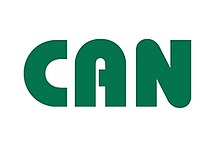Standard for serial communication between devices without host computer
Controller Area Network
 |
| Type |
Serial communication bus |
|---|
|
| Designer |
Bosch GmbH |
|---|
| Designed |
1983; 41 years ago (1983) |
|---|
| External |
No |
|---|
|
| Signal |
Differential |
|---|
| Max. voltage |
16V DC |
|---|
|
| Data signal |
Transceiver driven |
|---|
| Width |
1 bit (bidirectional) |
|---|
| Bitrate |
0.05, 0.125, 0.250, 0.500, 0.800 or 1.0 Mbit/s, up to 5.0 Mbit/s for CAN FD |
|---|
| Max. devices |
32, 64 or 127 (depending on standard) |
|---|
| Protocol |
Serial, half-duplex, Asynchronous |
|---|
|
| CAN-H |
CAN High (Yellow) |
|---|
| CAN-L |
CAN Low (Green) |
|---|
A controller area network (CAN) is a vehicle bus standard designed to enable efficient communication primarily between electronic control units (ECUs). Originally developed to reduce the complexity and cost of electrical wiring in automobiles through multiplexing, the CAN bus protocol has since been adopted in various other contexts. This broadcast-based, message-oriented protocol ensures data integrity and prioritization through a process called arbitration, allowing the highest priority device to continue transmitting if multiple devices attempt to send data simultaneously, while others back off. Its reliability is enhanced by differential signaling, which mitigates electrical noise. Common versions of the CAN protocol include CAN 2.0, CAN FD, and CAN XL which vary in their data rate capabilities and maximum data payload sizes.

